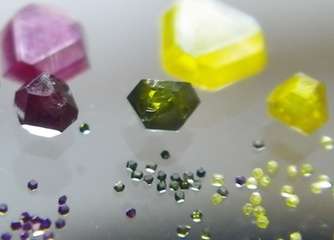August 11, 2014 weblog
Nanodiamond tech lights new path in medical diagnostics

Earlier this month TechCrunch featured a look at a company that wants to make a difference in finding cancer before it spreads using nanodiamond-based technology. The idea is that nanodiamonds can detect molecular abnormalities at an early stage, and as such could help a patient's chances for survival. The company is called Bikanta. Founded in 2013, the company is interested in what fluorescent diamonds inside the body can mean to the future of medical diagnostics. The company website said it has developed nanodiamond-based technology; nanodiamonds are superior optical probes with the key beneficial features such as biocompatibility, brightness and signal stability, and cost, the site added. Nanodiamonds are exquisitely sensitive to magnetic fields, said the company, and this sensitivity can be used to reduce background noise more than 100-fold over current methods and to improve visualization deeper into the body. Bikanta said it is also designing novel imaging scanners and microscopes to improve detection capabilities.
Ambika Bumb, PhD, is the CEO. A Georgia Tech graduate, she went on to receive her doctorate from Oxford. She became interested in the challenges confronting cancer research. Is there a better way to find disease as its source? Bumb, said TechCrunch, "discovered that crushing up essentially imperfect diamonds into dust created a fluorescent, reflective light that could highlight any molecular abnormality." She added in TechCrunch that it was like having "a flashlight inside your body that basically lasts forever."
Her company site notes the diagnostic advantages of nanodiamonds. "Fluorescent nanodiamonds never photobleach or blink. They are tiny fluorescent sources of steady and permanent near infrared light that can be leveraged to detect targets deep in tissue."
In an additional follow-up comment to the TechCrunch article, Bumb explained, "Current optical imaging agents do have the ability to specifically bind and image targets in tissue and in vivo. Where they are technically limited is by signal loss issues (photobleaching, photoblinking). Fluorescent nanodiamonds have permanent and infinitely stable fluorescent signal. They are also imageable deeper into tissue because of a second magnetic sensitivity property that can be manipulated to improve signal-to-noise ratio."
This would not be the first time close attention has been paid to nanodiamonds in the context of cancer detection. European researchers are also interested. An article appeared last year in youris.com, titled "Nanodiamonds: a cancer patient's best friend?" The article said, "nanometric scale diamond particles could offer a new way to detect cancer far earlier than previously thought. This is precisely the objective of a research project called Dinamo, funded by the EU. Specifically, it aims to develop a non-invasive nanotechnology sensing platform for real-time monitoring of biomolecular processes in living cancer cells."
More information:
— www.youris.com/Health/Cancer/N … ientS_Best_Friend.kl
— www.bikanta.com/
© 2014 Phys.org


















